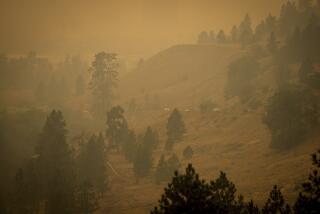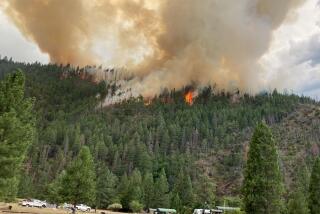Firefighters in Colorado grapple with strong winds
High winds forced Colorado firefighters to ground support helicopters Sunday but had little effect on the most destructive blaze in state history, officials said.
The Larimer County Sheriff’s Office said containment remained at 45%, with the 56,480-acre fire spreading about 1,500 acres.
“That’s pretty low growth, considering what this fire has done, and especially considering that red-flag warning” for high winds, sheriff’s spokeswoman Jennifer Hillmann said.
The 30- to 50-mph winds intensified the fire inside the containment lines, she said, and sent more smoke over nearby Fort Collins, about 15 miles east. Lightning sparked the blaze June 9.
At least 181 homes have been destroyed by the High Park fire, and that number is expected to grow.
“There are a still a lot of folks who don’t know whether they have homes or not,” said Kristy Wumkes, a spokeswoman for the firefighting effort. “They’re our friends, our neighbors. All of us know people who have lost homes.”
About 1,800 evacuation notices were still in place Sunday morning, Wumkes said. Another 331 evacuation notices were issued later in the day, and a few hundred more residents were warned that they might need to flee soon, officials said. In addition, 1,199 evacuation notices had been lifted.
The fire is growing westward, deeper into Roosevelt National Forest and farther from homes to the east.
Wumkes said none of the more than 1,600 firefighters had been reported hurt. At least one person has died.
Hillmann estimated the fire’s cost to date at $12.6 million, but could not say whether that included property damage or simply the cost of fighting the blaze.
A Denver man was arrested Sunday on suspicion of impersonating a firefighter. Police said Michael Maher, 30, was driving in a fire zone in a silver Toyota Tacoma with “phony firefighter credentials” and a stolen government license plate. When the truck was found later at a bar, it had a gun and stolen property inside, police said.
The fire’s busy western front presents a challenge for firefighters, who often have to deal with ridge after ridge of dense forest and sudden creek bottoms along with low humidity and high temperatures.
“A lot of steep gullies, cliffs — the slopes are quite vertical,” Wumkes said. “It’s like a double black diamond ski slope or steeper.”
The densely forested area also provides a lot of fuel. Officials have brought in equipment to essentially do on-the-spot logging, removing trees that are in the blaze’s path and creating space for firefighters to work and make a stand, Wumkes said.
“This is an area that’s had a lot of time to build up those fuels,” Wumkes said. “A lot of the trees in this forest are about 150 years old,” marking the time since a large fire last cleared out the area.
Accompanying the fire has been some political squabbling over the capabilities of the nation’s aging air-tanker fleet, often a fixture in tough-to-get-to wildfires.
The U.S. Forest Service’s newest heavy air tanker is 51 years old, according to the Denver Post, and only nine tankers remain in a fleet that numbered 44 a decade ago.
A forest service spokeswoman said it had enough air resources. But Jim Hall, a former National Transportation Safety Board chairman who headed a 2002 commission that recommended the forest service bolster its fleet, had serious concerns.
“It’s been 10 years, and precious little has been done,” Hall told the Denver Post. “We are going to see one of the major cities in the West go up in fire because of this inaction.”
More to Read
Start your day right
Sign up for Essential California for news, features and recommendations from the L.A. Times and beyond in your inbox six days a week.
You may occasionally receive promotional content from the Los Angeles Times.







